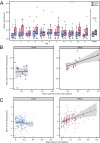Hippocampal ripples predict motor learning during brief rest breaks in humans
- PMID: 40603846
- PMCID: PMC12222441
- DOI: 10.1038/s41467-025-61136-y
Hippocampal ripples predict motor learning during brief rest breaks in humans
Abstract
Critical aspects of motor learning and memory happen offline, during both wake and sleep. When healthy young people learn a motor sequence task, most of their performance improvement happens not while typing, but offline, during interleaved rest breaks. In contrast, the performance of patients with dense amnesia due to hippocampal damage actually gets worse over the rest breaks and improves while typing. These findings indicate that an intact hippocampus is necessary for offline motor learning during wake, but do not specify its mechanism. Here, we studied epilepsy patients (n = 17) undergoing direct intracranial electroencephalographic monitoring of the hippocampus as they learned the same motor sequence task. Like healthy young people, they show greater speed gains across rest breaks than while typing. They also show higher hippocampal ripple rates during these rest breaks that predict offline gains in speed. This suggests that motor learning during brief rest breaks during wake is mediated by hippocampal ripples. These results expand our understanding of the role of hippocampal ripples beyond declarative memory to include enhancing motor procedural memory.
© 2025. The Author(s).
Conflict of interest statement
Competing interests: The authors declare no competing interests.
Figures



References
-
- Siapas, A. G. & Wilson, M. A. Coordinated interactions between hippocampal ripples and cortical spindles during slow-wave sleep. Neuron21, 1123–1128 (1998). - PubMed
-
- Girardeau, G., Benchenane, K., Wiener, S. I., Buzsaki, G. & Zugaro, M. B. Selective suppression of hippocampal ripples impairs spatial memory. Nat. Neurosci.12, 1222–1223 (2009). - PubMed
MeSH terms
Grants and funding
- R01NS119483/U.S. Department of Health & Human Services | NIH | National Institute of Neurological Disorders and Stroke (NINDS)
- MH092638/U.S. Department of Health & Human Services | NIH | National Institute of Mental Health (NIMH)
- UH3 MH125273/MH/NIMH NIH HHS/United States
- R01NS115868/U.S. Department of Health & Human Services | NIH | National Institute of Neurological Disorders and Stroke (NINDS)
- R01 NS119483/NS/NINDS NIH HHS/United States
LinkOut - more resources
Full Text Sources

